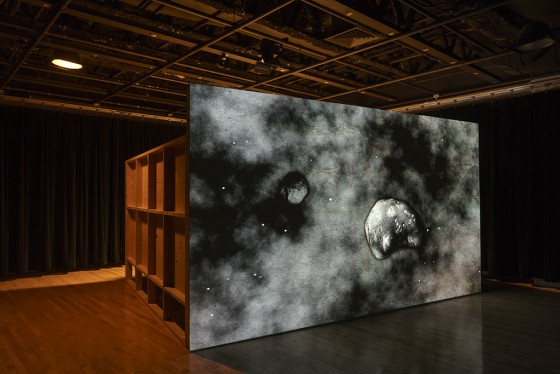First Contact



In this interactive installation the viewer controls video footage based on scenes from classic saucer films by playing a theremin, an early electronic instrument developed through Soviet research into proximity sensors.
Saucer films refer to a body of movies produced in the 1950s that feature flying saucers, a term coined by American businessman Kenneth Arnold after siting a formation of “nine disk-like objects zipping at tremendous speed” over Mount Rainier, Washington.
The 1950s mark an extraordinary time in human history. They arrive on the coattails of the Second World War where for the first time in history aerial bombings took place on a massive scale, leaving world capitals in ruins and an inconceivable number of human casualties estimated into the eightly millions. This unimaginable state of affairs was radically intensified by two unspeakable factors: large-scale genocide in Europe and the detonation of the first Atomic bomb. These factors ultimately lead to the rising fear of communism in the west, the ensuing Cold War, and fear of global annihilation. Less apparent, though perhaps equally significant was the rapid introduction of technology into the average North American and European household, due in part, to manufacturing processes developed by the war industry. By the 1950s technology was becoming commonplace in the lives and homes of average the North American - the car, telephone, television, electric toaster, washer and dryer, refrigerator and portable radio became ubiquitous household items at an almost alarming rate, permanently molding into place the concept of the modern nuclear family.
It is striking that in the wake of these events saucer films retain a naïve, unsullied quality that is indicative of the 50s era. Emphasized by crude production values and low-budget special-effects these early films have an innocent human feel. Sometimes referred to as First Contact films, saucer movies almost always take place in the present, are often situated on Earth and, possibly for budgetary reasons, represent aliens with humanlike qualities. This human resemblance is compounded by the role both radio and television newscasts played in these films, which were frequently acted out by well-known newscast personalities of the time, giving saucer films a distinct reality factor not often present in other space genre movies.
By the early 1960s saucer movies all but disappear but the basic fears associated with them - world annihilation, destruction of natural resources and the overwhelming impact of technology in general - are equally pressing today.
While this artwork addresses these issues and references the significant social and political events that brought them into being, it is also meant to engage the viewer playfully, to challenge their creativity and to indulge in the innocence characterized by these films.
Programming and electronic design: Martin Peach
Animation and video editing: Andreane Gagne and Lorraine Oades, Productions Assistants: Matthieu Sabourin and Jonathan Lemieux, Installation support: Robbin Deyo, Matthieu Sabourin, Bogdan Stoica, Pamela Simard
Photographs: Guy L'Heureux
The artist gratefully acknowledges the support of the Canada Council of the Arts, Media Arts and Concordia University Part-time Faculty Association, Professional Development.
___
© 2016 Loades









